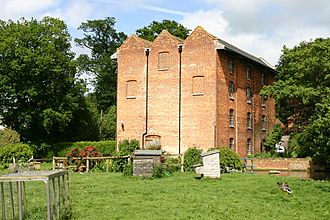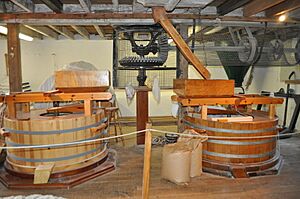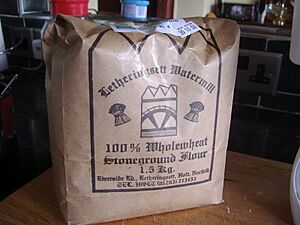Letheringsett Watermill facts for kids
Quick facts for kids Letheringsett Watermill |
|
|---|---|

Letheringsett Watermill west elevation.
|
|
| General information | |
| Type | Watermill |
| Location | River Glaven |
| Town or city | Letheringsett |
| Country | England |
| Coordinates | 52°54′22″N 1°03′54″E / 52.9062°N 1.0650°E |
| Opened | Present mill 1802 |
| Technical details | |
| Material | Brick built with black Pantile roof |
The Letheringsett Watermill is a special place located on the River Glaven in the village of Letheringsett, in England's county of Norfolk. This village is part of North Norfolk and is about 1.4 miles (2.2 km) west of the town of Holt. The watermill is a very important historical building, known as a Grade II* listed building. It is the only watermill in Norfolk that is still working and making flour today!
Contents
What is the Letheringsett Watermill Like?
The mill you see today was built in 1802. It is made from red bricks found in Norfolk and has a black roof made of special tiles called pantiles. This is a big building with four floors and pointy tops on its ends. Some of the windows are actually just brick designs.
How the Waterwheel Works
The waterwheel was built in a clever way. It could work in two different modes:
- Breastshot: This is when the water hits the wheel in the middle.
- Undershot: This is when the water flows under the wheel.
This design meant the mill could keep working even if the water levels in the river were low during dry weather.
To make sure there was enough water, the mill pond dam was made 2 feet (0.6 meters) taller in the 1800s. However, this caused some problems because nearby fields would flood when there was heavy rain, which made the local farmers unhappy.
A Look Back at the Mill's History
Watermills have been on this spot for a very long time! The Domesday Book, a famous survey from 1086, even mentions a watermill at 'Leringaseta'.
Early Owners and Fires
The first owner we know about was Thomas de Saxlingham in 1383. The mill that stands today replaced an older one that burned down in 1802. This wasn't the first time fire struck; another mill on the same site was also destroyed by fire in 1744.
Changing Power Sources
For many years, the mill used water power. But by 1941, it stopped using water as its main power source. Instead, a diesel engine was put in to run the mill.
However, in 1984, the miller, Peter Warwick, decided to change things back. He converted the mill from diesel power to water power again, which was the first time it had run on water in 40 years! Then, in 1987, a big project began to fully restore the watermill, led by Mike and Marion Thurlow.
What Happens at the Mill Today?
The Letheringsett Watermill is still a Grade II* listed building and is the last working watermill in Norfolk that makes flour.
Restoration and Reopening
The mill actually got some help from a big event: the Great Storm of 1987. This storm knocked down many trees, and 200 oak trees were used to fix 2,000 feet (610 meters) of beams and 10,500 feet (3,200 meters) of flooring in the mill. The roof was also replaced, and the waterwheel was carefully put back into its correct position.
In 1990, the watermill opened its doors to visitors. It started making about 2½ tonnes of stone-ground wholewheat flour every week. This flour was sold to people visiting the mill and to local shops.
Flour Production and Visitor Experience
Today, this busy mill makes many different types of flour, including whole wheat and spelt flour. You can buy all their products at the Mill shop. They also sell dried fruit, nuts, oats, muesli, and other baking ingredients.
Visitors can watch demonstrations of how the mill works. There are also tours of the mill on most weekday afternoons, though there is a small fee to enter. In 2007, more restoration work was finished. The grain floor and the bin floor were opened to the public. These areas are now used for exhibitions and learning, with old tools, photos, and videos. North Norfolk MP Norman Lamb officially opened these restored floors on October 6, 2007.



